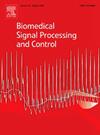A convolutional neural network for automatic detection of sleep-breathing events using single-channel ECG signals
IF 4.9
2区 医学
Q1 ENGINEERING, BIOMEDICAL
引用次数: 0
Abstract
Sleep apnea-hypopnea syndrome (SAHS) is a common sleep-breathing disorder, and the development of an automated method for detecting hypopnea and apnea is crucial for early prevention and treatment. Clinicians vary in their treatment approaches for sleep hypopnea and sleep apnea, often regarding sleep apnea as more severe. However, most previous methods for detecting sleep-breathing events were binary classifications that merged hypopnea and apnea into a single category, which are inadequate for auxiliary diagnosis and accurate sleep quality monitoring today. In this study, we proposed a convolutional neural network (CNN) model called TriGNet, which aims to detect hypopnea and apnea events. TriGNet utilizes single-channel electrocardiogram (ECG) signals from the MIT-BIH polysomnography dataset to learn and differentiate between normal, hypopnea, and apnea events. We designed a 2D feature extraction component in the model, which processes 1D ECG signal data as 2D to obtain additional feature information. In addition, this study proposed a dynamic data regulation mechanism for capturing subtle variations among the three categories of ECG signals. The TriGNet model can directly learn features from ECG signals and effectively classify sleep-breathing events. The proposed method achieved an accuracy of 94.08%, a macro F1 score of 93.02%, and a Cohen’s kappa coefficient of 89.91% on the test set. Experimental results show that the TriGNet model proposed in this study achieves state-of-the-art (SOTA) performance. You can find our source codes at https://github.com/MMMaoTS/TriGNet.
利用单通道心电信号自动检测睡眠呼吸事件的卷积神经网络
睡眠呼吸暂停低通气综合征(SAHS)是一种常见的睡眠呼吸障碍,开发一种自动检测低通气和呼吸暂停的方法对于早期预防和治疗至关重要。临床医生对睡眠呼吸暂停和睡眠呼吸暂停的治疗方法各不相同,通常认为睡眠呼吸暂停更严重。然而,以往大多数检测睡眠呼吸事件的方法是将低通气和呼吸暂停合并为一个类别的二元分类,这对于今天的辅助诊断和准确的睡眠质量监测是不够的。在这项研究中,我们提出了一个名为TriGNet的卷积神经网络(CNN)模型,旨在检测低呼吸和呼吸暂停事件。TriGNet利用来自MIT-BIH多导睡眠图数据集的单通道心电图(ECG)信号来学习和区分正常、低呼吸和呼吸暂停事件。我们在模型中设计了二维特征提取组件,将一维心电信号数据进行二维处理,获取附加的特征信息。此外,本研究提出了一种动态数据调节机制,用于捕捉三类心电信号之间的细微变化。TriGNet模型可以直接从心电信号中学习特征,有效地对睡眠呼吸事件进行分类。该方法在测试集上的准确率为94.08%,宏观F1分数为93.02%,Cohen’s kappa系数为89.91%。实验结果表明,本文提出的TriGNet模型达到了最先进(SOTA)的性能。您可以在https://github.com/MMMaoTS/TriGNet找到我们的源代码。
本文章由计算机程序翻译,如有差异,请以英文原文为准。
求助全文
约1分钟内获得全文
求助全文
来源期刊

Biomedical Signal Processing and Control
工程技术-工程:生物医学
CiteScore
9.80
自引率
13.70%
发文量
822
审稿时长
4 months
期刊介绍:
Biomedical Signal Processing and Control aims to provide a cross-disciplinary international forum for the interchange of information on research in the measurement and analysis of signals and images in clinical medicine and the biological sciences. Emphasis is placed on contributions dealing with the practical, applications-led research on the use of methods and devices in clinical diagnosis, patient monitoring and management.
Biomedical Signal Processing and Control reflects the main areas in which these methods are being used and developed at the interface of both engineering and clinical science. The scope of the journal is defined to include relevant review papers, technical notes, short communications and letters. Tutorial papers and special issues will also be published.
 求助内容:
求助内容: 应助结果提醒方式:
应助结果提醒方式:


